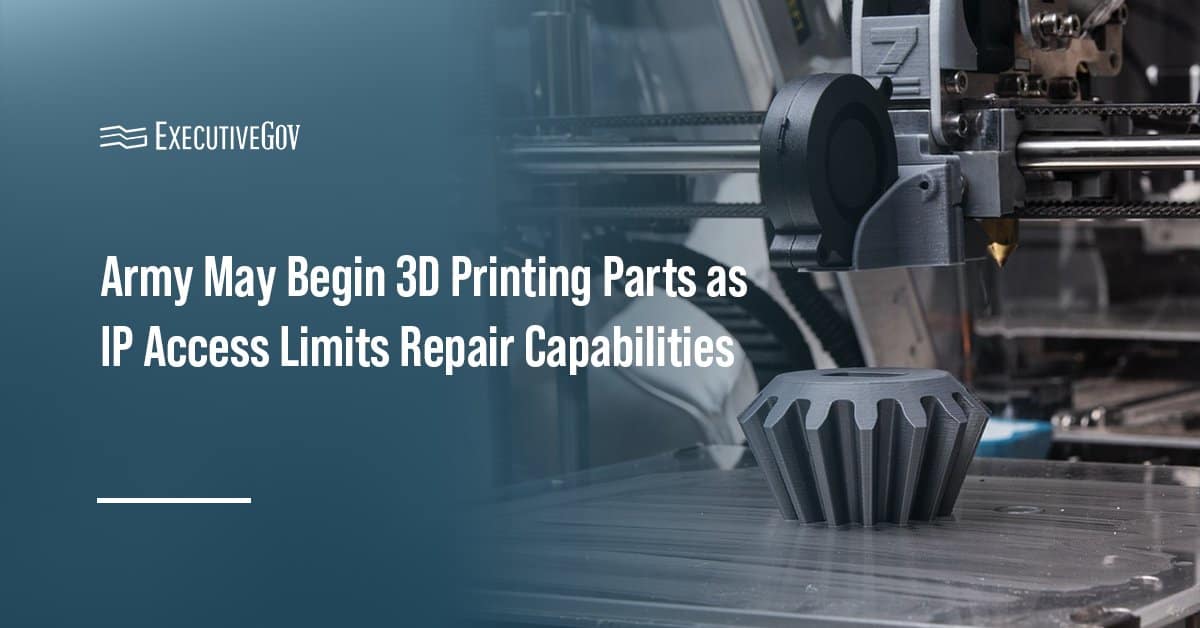The U.S. Army is considering expanding its use of 3D printing to produce more of its own replacement parts as it continues to face challenges accessing vendor-owned technical data, Breaking Defense reported.
According to Lt. Gen. Christopher Mohan, acting commander of Army Materiel Command, the service’s dependence on contractor intellectual property has slowed the repair and maintenance of key systems and platforms, prompting the service to look for ways to independently manufacture components when critical parts are unavailable.
“Don’t be surprised if you just see us doing things because we can’t wait,” Mohan said during last week’s Association of the U.S. Army conference in Washington, D.C. “I acknowledge that their intellectual property is their intellectual property. It is a shame on us for not buying it up front.”
Table of Contents
Why the Army Is Turning to Additive Manufacturing
Mohan described a recent case where one of the Army’s vehicles became inoperable due to a faulty valve in a tire. When the service sought technical data to reproduce the part, it discovered that the information was held by a subcontractor several tiers below the prime contractor, delaying repairs even further.
“We can’t live like that,” he said, noting that the Army is exploring models to purchase rights only for the parts it needs to print. “There’s got to be some kind of model that says, ‘Hey, we can buy the rights for just the part we need to print. We don’t have to buy the entire vehicle system or whatever.’”
The Army has been testing additive manufacturing capabilities to accelerate production and reduce supply chain bottlenecks. As part of one ongoing effort, the service is attempting to 3D print 60 components in 60 days, a pace that would significantly cut production times compared to traditional methods.
How Is the Army Enabling Field-Level 3D Printing?
To support rapid repairs in deployed environments, the Army has also built a digital repository of parts that soldiers can access and print directly in the field. Mohan said the repository contains basic, non-sensitive items such as fan grates and door handles, which can be produced through tactical networks using containerized printing setups.
“[Soldiers] were able to go through tactical networks all the way, tunnel up to the digital repository, download the part and print it out in the field, so we know it works,” he said, adding that the system still needs refinement but has proven effective in early use.
Leadership Endorses In-House Manufacturing
Army Secretary Dan Driscoll underscored the importance of the effort, highlighting a 3D-printed fin for a Black Hawk external fuel tank developed without vendor data.
“This may sound trivial, but simply being able to make or repair our own parts can save millions of dollars and save lives,” Driscoll said during his AUSA keynote.
According to Driscoll, the vendor’s replacement part cost about $14,000, while the Army reproduced it for just over $3,000. The in-house version was also “300 percent stronger and 78 percent cheaper.”
How Is the Army Changing Its Repair Authorization Policy?
Driscoll recently issued guidance giving soldiers greater authority to perform repairs in the field based on a risk-based framework. Under the policy, low-risk fixes can be authorized immediately, while medium- and high-risk repairs require further review.
Mohan said the policy marks a shift from the Army’s previous “one size fits all” approach, which often prevented even minor fixes without higher approval.
“I’ve been around the Army for a long time. I’ve never seen anybody get in trouble for fixing something,” he continued. “We’ve got to change the way we think.”





